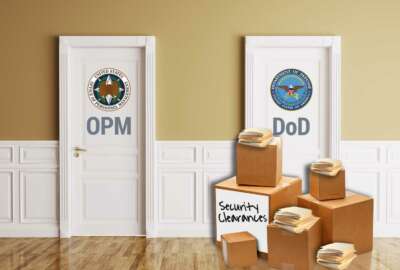
DoD to reorganize, create new security clearance organization
The Defense Department is planning to merge the National Background Investigations Bureau, Defense Security Service and other entities within the Pentagon to fo...
Best listening experience is on Chrome, Firefox or Safari. Subscribe to Federal Drive’s daily audio interviews on Apple Podcasts or PodcastOne.
The Trump administration is planning a sweeping, multi-faceted effort to officially transfer the governmentwide security clearance program from the Office of Personnel Management and the National Background Investigations Bureau to the Pentagon, multiple sources have told Federal News Network.
President Donald Trump is expected to sign an executive order that will officially authorize the move, which the administration first proposed back in June as part of its government reorganization plan.
DoD, meanwhile, has been preparing for months to restructure and reorganize personnel and resources to take over the security clearance program for most government, a Defense official told Federal News Network. That work first started when Congress initially authorized the department to assume responsibility for defense-only background investigations in the 2018 National Defense Authorization Act.
Once the president signs an EO transferring responsibility for the clearance program, DoD can officially announce its plans to merge the NBIB workforce with the Defense Security Service — as well as several other defense entities — to form an entirely new security clearance organization. Some of the details of the impending reorganization were first reported by Inside Defense.
Industry sources said an internal DoD memo will likely describe these changes, but the Defense official said the department may communicate the plans to employees in another way, and noted that only Congress can create an entirely new agency. But in the meantime, the Pentagon has some latitude to restructure its existing functions.
Three industry sources said the new investigative entity will eventually be called the Defense Counterintelligence and Security Agency (DCSA) and will eventually serve as the governmentwide security clearance provider.
The new agency will have a little more than 10,000 employees, including both federal and contractor investigators from NBIB and the Defense Security Service’s current workforce of approximately 900 employees, industry sources said.
Patricia Stokes, who currently serves as DSS’ director of defense vetting, will lead the new agency’s personnel vetting directorate, two industry sources said. The new clearance entity will have two other organizational “arms,” a Critical Technology Protection Center and a Counterintelligence and Analysis Center, the Defense official said.
Other small entities within DoD are also expected to move to the new clearance agency. DoD’s Consolidated Adjudications Facility (CAF) and counterintelligence resources from throughout the department will move to the new clearance organization, the Defense official said.
DoD’s CAF currently determines clearance eligibility once a background investigation is completed, evaluating both federal employees and contractors for their suitability to receive a clearance.
DSS already has a counterintelligence unit, but focuses only on threats to technology and programs within cleared industry providers. Combined with counterintelligence resources from DIA, the new security clearance agency would likely broaden its focus.
Creating a Critical Technology Protection Center and a Counterintelligence and Analysis Center is also in line with DSS’ long-held vision to change the way it oversees industrial security. The agency wants to move from a compliance-based “check the box” mentality to one that prioritizes cleared industry’s most important technology first, according to its “agency in transition” plans.
“The department is working diligently to reform the personnel vetting enterprise. We are working closely with our interagency partners and the Performance Accountability Council Program Management Office to ensure the successful transition of the mission while conducting background investigations,” Lt. Col. Audricia Harris, a DoD spokeswoman, said in a statement.
The Office of Personnel Management did not respond to requests for comment in time for publication.
It’s unclear who exactly would lead the DCSA at large. Industry sources said the DCSA director will likely report to the undersecretary of Defense for intelligence.
In addition, a Defense official said there aren’t plans at the moment to reassign or redistribute the responsibilities of the security executive agent (SecEA), which currently sit with the Office of the Director of National Intelligence (ODNI), or the suitability and credentialing executive agent (SuitEA), which reside with the OPM director. The Trump administration’s plans to reorganize OPM, however, may complicate the future of the suitability executive agent.
Margaret Weichert, who serves as both OMB deputy director for management and acting OPM director, technically holds two positions on the Performance Accountability Council (PAC) in her current capacity. The PAC is responsible for managing and overseeing the executive branch suitability and security vetting enterprise.
A Senate aide said lawmakers are continuing to hold quarterly briefings with PAC officials. The next meeting will be in January, and senators are planning a hearing on security clearances for the spring, the aide added.
Timing for these moves is also unclear. Multiple industry sources said the President could sign the executive order “any day now,” though they acknowledged they had heard of a similar timeline back in April, when, as Federal News Network first reported, the Trump administration expressed an interest in moving the entire security clearance portfolio.
Deputy Defense Secretary Patrick Shanahan is expected to announce these changes, but timing is also unclear.
Stuart Timerman, director of the Defense Information Systems Agency’s Development and Business Center, first publicly mentioned an internal memo to reporters at the agency’s forecast to industry earlier this month. Timerman said the memo will move the National Background Investigation Services information technology from DISA to DSS, with a plan to have the transition completed on paper by Oct. 1.
DoD emphasizes continuous evaluation
While top administration officials have been sorting out the details of an executive order and internal memo, DoD and NBIB have been busy whittling down the investigative backlog.
At its peak, the inventory of unprocessed clearances stood at 725,000, according to administration’s latest update on the topic on Performance.gov. The backlog today sits at around 600,000.
Much of the noticeable progress on the backlog is due to DoD’s concerted effort to enroll more clearance holders into a continuous evaluation (CE) process. The Pentagon is running short, initial checks on some clearance holders who are due for secret-level periodic reinvestivations. If no red flags come back, DoD has been directly enrolling them in CE, rather than performing a full-blown reinvestigation, industry sources said.
Related Stories
 Exclusive
Exclusive Trump administration preparing executive order to transfer security clearance program
“It takes a lot of reinvestigations out of the pipeline, which will help reduce the backlog, expedite the investigation of people who do need actual, full investigations and strengthen the use of near real-time electronic monitoring of people who are already in the trusted workforce,” said Larry Hanauer, vice president of policy for the Intelligence and National Security Alliance.
Though industry ultimately sees continuous evaluation as a crucial step in shaping an outdated investigation and adjudication process for the modern era, it won’t be the only solution to a clearance backlog that industry still sees as too large.
“Yes, they’ve made progress, but it’s a little bit of shell game,” one industry source said. “The big progress has simply been applying technology, as industry advocated for some time, and using the tools that are already out there to validate data.”
Hanauer said DoD’s still relatively new process poses questions for reciprocity, the concept that one agency accepts an employee or contractor’s clearance from another.
It’s still unclear, for example, if the intelligence community will accept individuals who were enrolled in DoD’s continuous evaluation program in lieu of having a periodic reinvestigation.
The ODNI has its own continuous evaluation program, which at least 20 agencies have signed up to use, principal deputy DNI Sue Gordon told industry and reporters in late October.
“As CE becomes more prevalent, reciprocity could improve if the security executive agent updates and enforces related policies,” Charlie Sowell, chief operating officer for iWorks Corporation and a former senior adviser to the director of national intelligence, said. “Without strong SecEA action though, reciprocity under CE could actually get worse than it is today.”
Reciprocity will become increasingly more important in a new environment, particularly as DoD assumes control of the security clearance process for all of government, said Wes Hallman, senior vice president of policy for the National Defense Industrial Association.
“Increasingly we’re running in whole-of-government. If you’re going to operate in whole-of-government, you need reciprocity over time,” he said. “This is going to be a continued issue that needs to be addressed as we move forward. Without reciprocity, you’re still going to have those barriers, not just to information but to have that workforce shift where needed.”
Will common investigative standards bring solutions?
Hanauer and other members of industry say uniform standards for investigations, adjudications and continuous vetting are key to resolving some of the more frustrating challenges they see with reciprocity.
Common standards would also ease the burden on contractors, who often have employees supporting work for multiple agencies, and may make it more feasible for security clearances to become portable assets that contractors can take with them from organization to organization.
“We want to make sure we can get the right people to the right mission needs. We’ve found reciprocity to be a significant challenge,” one industry official said. “It’s a little confusing. If you’re good in one agency, why aren’t you good in another agency?”
Gordon said ODNI is developing updated standards, which she expects will be finished by the end of 2019.
“If you have a single common standard, then the investigation and adjudication process can move more quickly,” Hanauer said. “You can speed up reciprocity across agencies, because agencies won’t have any questions about whether someone from another meets their standards. There’s only one standard.”
Though Gordon predicted common standards by the end of next year, the intelligence community hasn’t always moved with speed in developing new policy.
And as DoD assumes investigative responsibility for nearly all of government, industry is seeking reassurance that government will prioritize contractors’ pending clearances as the Pentagon continues to work down the backlog.
Government’s ability to get work done depends on it, and contractors don’t have much more time to wait, an industry official said.
“Most young people coming out of school can’t wait over a year to get a clearance to get their first job,” the official said. “With the government focused on reducing the cost of programs, we can’t afford to carry people while they’re awaiting clearances. They either go off and do something else or get a great job with Amazon or Google or something really cool. It’s a bit of vicious circle. The RFPs keep coming out. Government wants newer technologies [and] a less expensive workforce, but that’s the workforce that they need to focus on clearing.”
Copyright © 2024 Federal News Network. All rights reserved. This website is not intended for users located within the European Economic Area.
Nicole Ogrysko is a reporter for Federal News Network focusing on the federal workforce and federal pay and benefits.
Follow @nogryskoWFED






